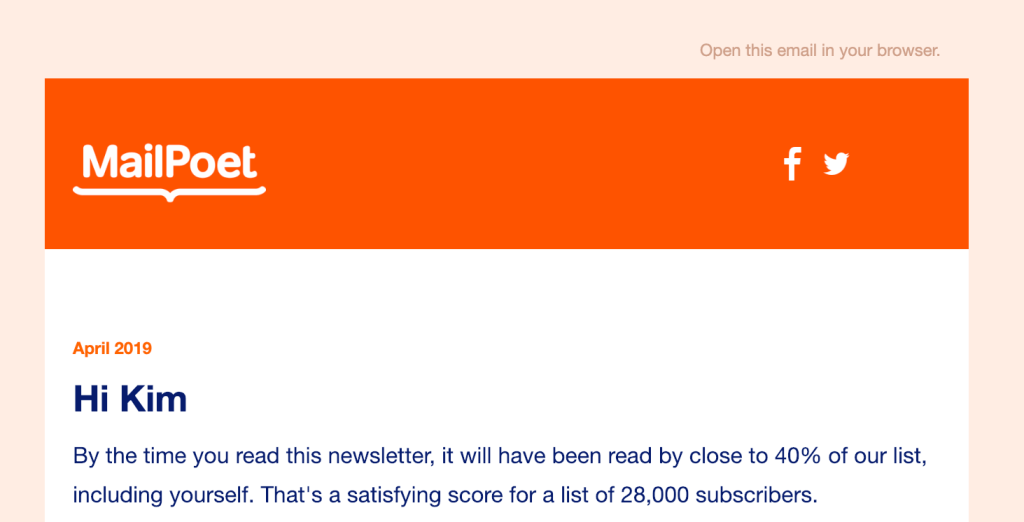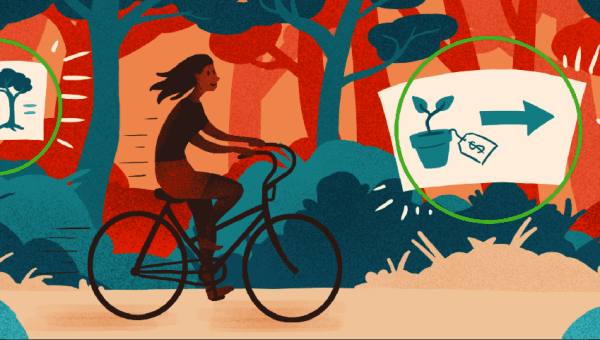If you find that your email open rate is declining over time or if it has dipped below 20%, it’s time to action!
Why is that happening in the first place? Well, it’s not unusual for some of your subscribers stop engaging with your emails over time, even after just a month. This happens to every email marketer because subscribers are more likely to disengage than unsubscribe.
The truth is, subscriber engagement is not equal across your list. Consider this: a quarter of subscribers account for over 80% of opens, according to a Return Path research.
For instance, at MailPoet, we recently deleted 10,000 inactive subscribers from our list of 38,000, thanks to a feature in our plugin that automatically removes inactive subscribers. Since doing this, our open rates have doubled from 20% to 40%. In fact, 95% of MailPoet use this exclusive feature to keep their list tidy.
You might be thinking, isn’t it counterintuitive to reduce your list and remove subscribers after working so hard grow your list in the first place?
In this post, I hope to change your mind by redefining the challenges you face once your list starts to grow.
I’ll cover everything you need to know about disengaged subscribers on your email list and what you can do about them, including:
- What are inactive subscribers?
- Why are they becoming inactive?
- Why are inactive subscribers a problem?
- 10 ways to better engage with inactive subscribers
What are inactive subscribers?
Inactive subscribers are those who are no longer opening your emails after a year, or even after a month.
Most MailPoet users with an email list older than one year and with under 5,000 subscribers have about 30% inactive subscribers.
For much larger lists, like, over 100,000 subscribers, we’ve seen disengagement of up to 30% after just 3 months. These lists typically get daily emails.
In the enterprise segment, SilverPop, a marketing automation tool by IBM, states they expect 40% inactive subscribers in their customers’ lists.
Why are subscribers becoming inactive?
Subscribers are more likely to ignore your emails than unsubscribe. It’s only natural, after all.
Take a look at your own spam folder (or Promotions folder in Gmail) to see if you are guilty of not managing your own subscriptions. We all neglect the task of upkeeping our subscriptions because we have better things to do with our busy lives.
The common reasons subscribers disengage with your emails include:
- They get too many emails.
- They are no longer interested in your content and don’t bother unsubscribing.
- Your content is not that interesting.
- Their interest have changed.
- They don’t open their inboxes often.
- They signed up with a secondary email account, not their primary.
- Your emails are landing in their spambox over time.
Why are inactive subscribers a problem?
Repeatedly sending emails to disengaged subscribers can damage your deliverability, even when engaged subscribers are opening your emails.
Yes, you read that right — sending to disengaged subscribers can potentially prevent your emails from being delivered to the inbox of everyone on your list, not just the people who are not opening.
The deliverability team here at MailPoet has seen this happen with Outlook, Yahoo, and Gmail. These Email Service Providers (ESP) closely observe subscriber engagement, starting with the first email you send to your subscribers.
We monitor each and every one of the 30+ million emails that passes through our servers each month, ensuring they reach their destination, leaving no email behind. It’s how we maintain our 98.5% rate, matching and often exceeding industry standards.
Just like in real life, once your credibility is damaged, it’s a lot more work to get back to where you were in the first place. ESPs — that’s the companies that provide you with an email account — give you a “reputation” based on how you act towards your subscribers to ensure that you don’t start acting like a spammer.
With email marketing, quantity is great, yes. But if the quality of your emails is poor, you’re fighting a losing battle in terms of inbox delivery – there’s no point sending email to people who don’t open them.
How to keep your subscribers engaged
Below, you’ll find 10 ways to ensure that you’re doing your best to keep your subscribers as engaged as possible — and opening your emails when they land in their inbox.
1. Stop sending email to inactive subscribers right now
First off, see how much your email list is affected by inactive subscribers, and send an email only to active subscribers, at least once, to experiment.
All email marketing solutions allow you segment your list by engagement so you can target inactive subscribers.
For example, find out how many of your subscribers haven’t opened your emails in the past 12 months or the last few newsletters you’ve sent to your list. We suggest removing them from your list right now.
In MailPoet, the “Stop sending to inactive subscribers” feature is turned on by default:

95% of MailPoet users keep this option turned on because it’s the single best way to keep list hygiene.
2. Engage immediately with a welcome email
Since ESPs want to see your engagement to decide how to filter your emails, you need to make sure your subscribers engage immediately with your emails after they subscribe and while your brand is still fresh in their minds. In a week’s time, their interest might have already waned, so it’s important to act fast.
A good way to start on the right foot is to set up a Welcome Email that sends immediately after someone signs up to your email list. These types of emails have great open rates, often above 50%.
Gmail will show your first email in subscriber inboxes before deciding whether or not your email should go to another tab, such as the Promotions tab.
3. Send a survey 3 months after sign up
The idea here is to send an automatic email with a subject line like: Tell me how we’re doing in under a minute.
This tactic serves 2 purposes: engage your subscribers after a longer period of time by asking their opinion and to help you learn how to improve your email strategy.
Recipients of newsletters tend to not reply, possibly out of fear they won’t get a response. A clear call-to-action, like a button, asking for their honest feedback can help drive clicks.
With MailPoet, you can set up a Welcome Email that you can automatically send to subscribers up to 24 weeks after they sign up.
4. Give your emails a personalized touch
Emails that use the recipient’s first name in the subject line see a 37% increase in opens compared to non-personalized subject lines, according to Experian.
For example:

This might sound a tad optimistic, but there’s no harm in adding more personalization to your emails.
5. Give them an offer they can’t refuse
This only applies if you are selling something, typically if you run a WooCommerce store.
Why not give your subscribers a special treat to see if this will encourage them to open your email?
Make sure the incentive is in the subject line, e.g. “We miss you – 10% off your next order” or “It’s been a while – Free Post & Packaging.”
When considering the offer, do try to make sure the subscriber has actually been a customer previously (i.e. they actually bought something from your WooCommerce store), otherwise it sounds a little weird!
If they have never purchased anything, try something like “10% off – can we tempt you?” If they respond, take them off the inactive list.
6. Consider reducing the number of emails you send
Are you sending at the right frequency? If you’re not sure, ask your subscribers directly by adding a link to a survey in your next newsletter.
Depending on the feedback you get, you could lower the frequency and send few emails. For example, if you send an email every week, trying send emails once a month, for two months.
If you have a lot of very good content, you might want to try doing the exact opposite and start sending more emails.
7. Send an ultimatum
Be warned for this one: if your subscribers are ignoring your previous emails, our experience shows that they’ll probably ignore a last warning.
You still want to try a last ditch effort? That’s OK, it’s always going to happen! It’s human nature to keep ignoring our inboxes sometimes rather than unsubscribing.
But what if you were asked directly “Do you still want to hear from us?” Wouldn’t that make you sit up and decide?
It’s a good idea to remind them why it’s good to be on the list e.g. “Be first to hear about xxx” or “Keep up to date with everything that’s going on…” and ask them if they still want to stay.
Give them a date which they need to respond by and let them know that if you don’t hear from them they’ll be removed from the list.
A “yes” button or link in your email could take subscribers to a specially created landing page on your site with some simple copy like “Thanks, we’ll keep you on the list”. A “No” button/link could take users to an unsubscribe page. Non-responders could be unsubscribed, too.
8. Review your unsubscribe process
You should have a healthy rate of unsubscribes for each of your email campaigns. Typically, it’s just under 1%.
But it should definitely not be close to 0%. If you find this is the case for your email list, make sure the unsubscribe process is nice and clear because users might be experiencing issues when trying to leave your list.
For starters, ensure that subscribers can find the unsubscribe link easily. Make sure:
- It’s written as “unsubscribe.” Avoid poetic synonyms.
- It’s at the bottom of your email and not somewhere else.
- It’s in a readable size. Don’t make people squint!
- It actually looks like a real link and not just text.
- It’s not in the middle of a long paragraph.
- It’s not competing with several other links in the same space.
Here’s what our unsubscribe link looks like in our newsletters:
A warning sign that your unsubscribe process might be broken is when the unsubscribe rate is zero. In this case, try unsubscribing yourself from your own list as any other subscriber would do. Surprisingly, you’ll find that this process can be easily improved.
9. Segment your lists
If you identify yourself by these 4 attributes:
- I have a list that’s getting quite big,
- I send emails more than once a month,
- I have quite a bit of quality content, and
- I totally dig this email thing!
… then you might want to segment your email list. This will allow you to send content that interests different, smaller groups of your subscribers.
For more, read our segmentation for beginners guide.
10. Make your content great (again!)
I’ll end this post with this tip — though you really should begin with this one first!
You should ask yourself why subscribers might not be enjoying your content.
It’s never too late to make your WordPress website shine with top blog posts and content.
Our definitive guide on writing is a must if you want your readers to enjoy themselves (as much as Google does).
In summary
It’s completely normal to have inactive subscribers on your list that ignore your emails instead of unsubscribing.
If you don’t take action, these subscribers can make up over 30% of your list within a year — our deliverability team has seen it happen.
Don’t wait too long otherwise your emails might be considered spam by ESPs like Gmail who consider engagement when filtering your emails.
Your loyal and engaged readers might become collateral damage and never get your emails, so act fast to preserve the quality of your list and open rates.
The recommendations here have even made it into our guide to newsletters in WordPress. Check it out!




Discussion